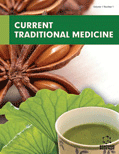Abstract
Background: Azadirachta indica(Neem) is an important medicinal plant that is traditionally known for its insecticidal, and antimicrobial properties.
Objective: The objective of present study was to evaluate the in-vitro antidiabetic activity and characterize the chemical constituents of Neem extract. Materials and Methods: The chemical constituents in ethyl acetate extract of the Neem leaves were determined by GC-MS and the in-vitro antidiabetic activity of Neem extract was evaluated via the inhibition of α-amylase and α-glucosidase enzymes. Results: The ethyl acetate extract of Neem yielded 49 chemical compounds and these constituents amounting to 97.07% of total Neem leaf extract composition. The major chemical components of the Neem were octadecanoic acid (7.17%), propyl tetracosyl ether (5.35%), 1-decanol, 2-octyl (5.01%), hexadecane (4.70%), tricosane (4.73%), octadecane, 1-chloro (4.65%), and linolenic acid (4.35%). The Neem extract produces dose dependent-inhibition of α-amylase and α-glucosidase enzymes ranging from 21.67±2.81 to 75.82±3.44% and 17.04±4.43 to 58.44±1.21% for concentration 31.25 to 1000 μg/mL, respectively. The IC50 values for Neem extract and acarbose were 165.53±2.75 and 91.04±2.16μg/mL, respectively against the α-amylase enzyme. The IC50 values for Neem extract and acarbose were 210.08±2.16 and 120.05±2.16 μg/mL, respectively against the α-glucosidase enzyme. Conclusion: The study findings suggested that Neem may be used as drug candidate in the management of post prandial hyperglycemia.Keywords: Azadirachta indica, Neem, GC-MS, α-amylase, α-glucosidase, PPHG, diabetes.
Graphical Abstract
Current Traditional Medicine
Title:Analysis of Chemical Composition by GC-MS and In-vitro Antidiabetic Activity of Azadirachta Indica Leaves Collected from Erbil, Iraq
Volume: 7 Issue: 4
Author(s): Javed Ahamad*, Subasini Uthirapathy, Esra T. Anwer, Muath Sh. Mohammed Amee and Faiq H.S. Hussain
Affiliation:
- Department of Pharmacognosy, Faculty of Pharmacy, Tishk International University, Erbil, Kurdistan Region,Iraq
Keywords: Azadirachta indica, Neem, GC-MS, α-amylase, α-glucosidase, PPHG, diabetes.
Abstract: Background: Azadirachta indica(Neem) is an important medicinal plant that is traditionally known for its insecticidal, and antimicrobial properties.
Objective: The objective of present study was to evaluate the in-vitro antidiabetic activity and characterize the chemical constituents of Neem extract. Materials and Methods: The chemical constituents in ethyl acetate extract of the Neem leaves were determined by GC-MS and the in-vitro antidiabetic activity of Neem extract was evaluated via the inhibition of α-amylase and α-glucosidase enzymes. Results: The ethyl acetate extract of Neem yielded 49 chemical compounds and these constituents amounting to 97.07% of total Neem leaf extract composition. The major chemical components of the Neem were octadecanoic acid (7.17%), propyl tetracosyl ether (5.35%), 1-decanol, 2-octyl (5.01%), hexadecane (4.70%), tricosane (4.73%), octadecane, 1-chloro (4.65%), and linolenic acid (4.35%). The Neem extract produces dose dependent-inhibition of α-amylase and α-glucosidase enzymes ranging from 21.67±2.81 to 75.82±3.44% and 17.04±4.43 to 58.44±1.21% for concentration 31.25 to 1000 μg/mL, respectively. The IC50 values for Neem extract and acarbose were 165.53±2.75 and 91.04±2.16μg/mL, respectively against the α-amylase enzyme. The IC50 values for Neem extract and acarbose were 210.08±2.16 and 120.05±2.16 μg/mL, respectively against the α-glucosidase enzyme. Conclusion: The study findings suggested that Neem may be used as drug candidate in the management of post prandial hyperglycemia.Export Options
About this article
Cite this article as:
Ahamad Javed *, Uthirapathy Subasini , Anwer T. Esra , Amee Sh. Mohammed Muath and Hussain H.S. Faiq , Analysis of Chemical Composition by GC-MS and In-vitro Antidiabetic Activity of Azadirachta Indica Leaves Collected from Erbil, Iraq, Current Traditional Medicine 2021; 7 (4) . https://dx.doi.org/10.2174/2215083807999201230123003
| DOI https://dx.doi.org/10.2174/2215083807999201230123003 |
Print ISSN 2215-0838 |
| Publisher Name Bentham Science Publisher |
Online ISSN 2215-0846 |
 8
8
- Author Guidelines
- Bentham Author Support Services (BASS)
- Graphical Abstracts
- Fabricating and Stating False Information
- Research Misconduct
- Post Publication Discussions and Corrections
- Publishing Ethics and Rectitude
- Increase Visibility of Your Article
- Archiving Policies
- Peer Review Workflow
- Order Your Article Before Print
- Promote Your Article
- Manuscript Transfer Facility
- Editorial Policies
- Allegations from Whistleblowers
- Announcements
Related Articles
-
Nutriproteomics – Linking Proteomics Variation with Personalized Nutrition
Current Pharmacogenomics and Personalized Medicine Screening Strategies to Identify New Antibiotics
Current Drug Targets C-reactive Protein, Infection, and Outcome After Acute Ischemic Stroke: A Registry and Systematic Review
Current Neurovascular Research Editorial [Hot Topic: Chelating Agents in Different Human Diseases (Guest Editor: Valeria Marina Nurchi)]
Current Medicinal Chemistry Ontologies of Drug Discovery and Design for Neurology, Cardiology and Oncology
Current Pharmaceutical Design NF-κB Signaling Pathway Inhibitors as Anticancer Drug Candidates
Anti-Cancer Agents in Medicinal Chemistry Anti-VEGF Drugs in Eye Diseases: Local Therapy with Potential Systemic Effects
Current Pharmaceutical Design Obesity and Inflammation: Colorectal Cancer Engines
Current Molecular Pharmacology Strategies for Development of Antimalarials Based on Encapsulated Porphyrin Derivatives
Mini-Reviews in Medicinal Chemistry “Letting the Air In” Can Set the Stage for Tumor Recurrences
Current Cancer Therapy Reviews Resveratrol: New Avenues for a Natural Compound in Neuroprotection
Current Pharmaceutical Design Recent Advances in Characterizing Natural Products that Regulate Autophagy
Anti-Cancer Agents in Medicinal Chemistry Editorial [Hot Topic: Coming Back to Nature: Plants as a Vital Source of Pharmaceutically Important Metabolites (Guest Editor: Milen I. Georgiev)]
Current Medicinal Chemistry A Glycemic Threshold of 90 mg/dl Promotes Early Signs of Atherosclerosis in Apparetly Healthy Overweight/Obese Subjects
Endocrine, Metabolic & Immune Disorders - Drug Targets Rosuvastatin may have Neuroprotective Effect on Spinal Cord Ischemia Reperfusion Injury
CNS & Neurological Disorders - Drug Targets Intracellular Redox State as Target for Anti-Influenza Therapy: Are Antioxidants Always Effective?
Current Topics in Medicinal Chemistry The Heme-Heme Oxygenase System in Wound Healing; Implications for Scar Formation
Current Drug Targets New Biological Approaches in Asthma: DNA-Based Therapy
Current Medicinal Chemistry Incretins and Preservation of Endothelial Function
Cardiovascular & Hematological Agents in Medicinal Chemistry Brain Oxidative Markers in Stress: Possible New Drug Targets Against Neuroinflammation
Current Neuropharmacology



























